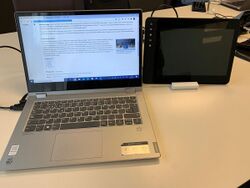Second display
A second display or second displays increases the area available to display images, text or video messages and can provide a screen that will allow human-computer interaction. Second displays have a wide variety of uses such as: allowing multiple application use, customer interaction in shops and digital signage. Connecting multiple monitors to a workstation has been generally possible since the multiple monitor feature in the Windows 98 operating system from 1998 allowing up to nine connected monitors. The following years the multiple monitor feature saw many enhancements like for example when Harold J Webber invented his multiple monitor performance optimisation in 2000.[1] Today it is particularly common to have one workstation with two monitors connected where the second monitor is referred to as the second display. Many tablets will serve as your second display connected to a laptop. [2] In many shops today you will see a checkout with two screens, one facing the cashier and a second display facing the shopper.
Today's second display has evolved from a multi screen personal computer monitor to having multiple technical features such as a touchscreen, web cam or even a barcode reader in stores.[3]
Consumers and support staff commonly use the term “second display” when referring to the second monitor in a multi-monitor setup. In 2017 LG unsuccessfully tried to copyright the term “second display”, meaning that it is available for everyone to use freely.[4]
Professional meaning
Retail and hotel businesses have a professional meaning for a "second display", also known as interactive customer display or dual-screen. The term is used in retail and hotel environments when referring to a customer facing display that is connected to the point of sale (POS) system. Normally a second display solution contains both hardware and interactive software allowing the shopper to perform certain actions. The second display normally shows the total purchase amount, the purchase list along with other functionality around loyalty and member data. The second display is most commonly used to show the total purchase amount and the purchase list. Some advanced systems contain functionality relating to loyalty and member data. The second display can draw shoppers' attention to new products, advertisements, charities, or special offers. The displays can also be used for different kinds of user input - for example entering an email to receive an electronic receipt, give feedback or sign up for loyalty to the customer relationship management (CRM) system.
See also
- Multi-monitor
- Dual-touchscreen
- Touchscreen
- Second screen
- Sales promotion
- Point of sale
References
- ↑ "Multiscreen personal computer display method and apparatus". GooglePatents. https://patents.google.com/patent/US6522309B1/en.
- ↑ "Ex-Apple engineers turn your iPad into a second display". Duet Display. https://www.duetdisplay.com/.
- ↑ "Extras". ID24. https://id24.com/Screen-scanner/.
- ↑ "Intellectual property in the European Union". EUIPO. https://euipo.europa.eu/eSearch/#details/trademarks/014362248.
Category:Display devices
Category:Display technology
 |



